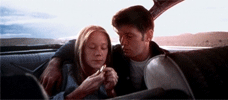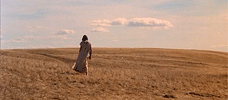Reviews
Terrence Malick
USA, 2005
Credits
Review by Michael Nordine
Posted on 26 May 2011
Source New Line BD
External links
Features
Songs of Innocence and of Experience by Leo
Categories Another World: Terrence Malick at LACMA
There is only this. All else is unreal.
In terms of reception, The New World is far and away the strangest of Terrence Malick’s films. Released in 2005 to lukewarm reviews and barely able to make back its production costs, it was later hailed as one of the best films of the decade by The A.V. Club (who ranked it ninth), Slant Magazine (fourth), Time Out New York (also fourth), Reverse Shot (second), and the San Francisco Chronicle (first), among others. (It also featured prominently in our own contributors’ poll.) The importance of such lists may not exactly be self-evident, but they certainly point to the resonance of certain films - and, if this is any evidence, The New World left an impression on quite a few. Malick has always been a critical darling, and in a way this is nothing new: Badlands and Days of Heaven have long been considered masterpieces, and The Thin Red Line was nominated for seven Academy Awards. But his take on the settling of Jamestown and the romance between John Smith and Pocahontas was exceptionally divisive.
Were I to venture a guess as to why there exists such a disparity between The New World’s immediate reception and eventual esteem, it’d likely have to do with the similar discrepancy between the film’s three incarnations. The first, which screened for critics and the few in New York and Los Angeles who saw its weeklong limited release, has a running time of 150 minutes. Malick both removed and added content for the wide release, resulting in a version that’s fifteen minutes shorter than the original. Finally, an extended cut running eight minutes short of three hours was released on DVD in late 2008. Having seen the latter two, I feel comfortable in saying the extended cut is unquestionably superior, as the truncated version mostly elides precisely what it is about The New World that makes it identifiable as a Terrence Malick film: long shots of nature and wistful narration. This version is a hard film even for fans of the auteur to like, and even I was initially disappointed by it. Another possibility, which I’ll mention briefly before moving on to the film proper, is that The New World was the first of Malick’s films to be released after the advent of Metacritic and Rotten Tomatoes. Its 171 reviews on the latter site total 100 more than there are for The Thin Red Line, and more than twice as many as for Badlands and Days of Heaven combined. It’s entirely possible, then, that The New World isn’t an outlier so much as the first of Malick’s films whose full reaction is still known. The Tree of Life’s release later this week may shed more light on this question; for now, I’ll just have to wonder.
Among the many recurring motifs - visual, sonic, visceral - in The New World, few are as in keeping with its overall mood as the second movement of Mozart’s Piano Concerto No. 23. Several pieces of music are heard just as frequently throughout the film, but none of them embody the melancholic longing of Terrence Malick’s fourth directorial effort in quite the same way. Sorrow, whether in two lovers’ faces or heard in the voices of the settlers of an unforgiving land, comes in droves in The New World, and this composition’s gentle piano strokes and rising crescendos speak to it in a unique way - there’s an inherent fragility coursing throughout.
Just as precious are the singular moments which pass by almost unnoticed: Pocahontas clasping her hands while looking up as though she’s trying to grasp the sun, parrots quietly squawking while perched on a woman’s arm, fingers running through tall grass. The New World, perhaps even more so than the rest of Malick’s films, derives its meaning more from the accumulation of such moments than from any sense of a streamlined narrative. The first of these moments is heard before it’s seen. With the screen black, the stirring of cicadas and gentle lapping of water is the only cue we’re given as to the film’s setting. Much of what follows in The New World is a sensory feast - as well as an exercise in actually looking at and listening to what it is Malick has created - but it begins with a moment of restraint. We then see a stationary, humbly composed shot of water set to these words:
Come, spirit. Help us sing the story of our land. You are our mother, we your field of corn. We rise from out of the soul of you.
This is an instant return to Malick’s most distinct stylistic flourish, but it’s also something of an inversion. Here we have Pocahontas speaking directly to the maternal Earth and not, as in previous films, to us or to the ether. The addressee of her thoughts is identifiable, but it isn’t us. Following a brief shot from below of Pocahontas extending her arms into the sky, we’re offered a cartographic title sequence which, like that of Days of Heaven, is a vividly realized overture for what’s to come: sailboats move assuredly across a map of the world as it was centuries ago. Toward what land have they pointed their sails? Malick doesn’t take long to answer. “Virginia, 1607” soon flashes across the bottom of the screen, and we see English boats about to make landfall. What’s remarkable about this opening sequence is that we see it through the eyes of the Powhatan tribe, who already live on that land and regard these “floating islands” with a mixture of fear and curiosity. Like them, we’re tasked with looking upon this story as though it were completely new to us. The New World is a film about discovery and all that comes with it: awe, violence, love, excitement, and, perhaps most familiar to Malick’s previous films, the loss of innocence.
Discovery is, of course, not an endpoint but a beginning, and Malick’s treatment of it in these opening seconds and minutes is of the utmost importance. What starts in innocence so often ends in disappointment and ruin. Smith speaks of creating “a true commonwealth” built on hard work and virtue but Jamestown, for him, ends up being a land whose bleakness is surpassed only by the treachery of the men who inhabit it. His conflict with his own people is dwarfed by that between the English and the Powhatan (who are referred to as “the naturals”), which itself is compounded by the language barrier between the two groups. As with Witt and the Japanese soldiers he comes across late in The Thin Red Line, to not understand the words coming out of another man’s mouth is often to immediately think him an enemy.
The slow process by which Smith and Pocahontas (and to an extent, he and her people) - portrayed beautifully in fragmented scenes of him teaching her such words as “lips” and “sky” - are as tender as they are deeply implicative. Even the words Pocahontas wants to be taught are telling: she cares not for Smith’s armor or weaponry, only how to describe the world around her in another tongue. The New World is a tactile, experiential film; all of Malick’s work focuses an inordinate amount of attention on images of outstretched hands, but here the mere act of touching something is shown to be a distillation of the film’s main preoccupation. Discovery is a sensory experience by nature, and to lightly run one’s fingers through someone’s hair in The New World is to know them in some fundamental way. Malick sees great beauty in this act, both in its innocence and the loss of innocence that accompanies it. To come into contact with something new is to change both parties, and any amount of assimilation is in a way a loss of one’s self.
Smith returns from his dreamlike stay with Pocahontas and her people to hungry, chattering children; to pestilence and death; to mutinous, half-mad men who argue over the date and eat the hands of a recently-dead companion. It’s grey, muddy, and cold. Mere miles away is utopia. Are the men cursed with infertile land, or are their hunger and treachery endemic to their own nature? No doubt a certain amount of hardship is to be expected when building a colony, but the “headless multitude” who make up Jamestown seem foredoomed to failure. The sanest of them are ready to make Smith their new leader. Like Witt in The Thin Red Line, he’s seen another world, and his men are quick to champion him in the hope that he can make their already-spoiled colony more like that of the naturals. This section of the film, in which Jamestown is slowly built up and the colonists’ conflict with the naturals ratchets up, is The New World’s darkest and most lugubrious. Already Smith’s time with the Powhatan seems unreal: “It was a dream,” he says. “Now I am awake.” There can be no true return to that which has already passed by, and any attempt to do so will invariably be mired in disappointment and sorrow. All one can do is move forward, but what to do when the future holds no promise? After their initial time together, Smith and Pocahontas rarely see one another. Their few remaining interactions are oases of joy and tenderness scattered across the long days. “There’s something I know when I’m with you that I forget when I’m away,” he tells her.
The extended cut of the film is divided into intertitled subsections whose ebb and flow mimics that of the shores on which it’s set. Flowers blossom and die, seasons flow into one another, the tide rises and recedes. Likewise, relationships - between people and each other, people and peoples, people and the land - come and go in time. The understated romance between Smith and Pocahontas is in some ways The New World’s central concern, but out of it grows a beauty laced with sorrow with which Malick is equally if not more concerned.
Malick’s own Days of Heaven is sometimes cited as the most beautifully photographed film of all time, but to my mind Emmanuel “Chivo” Lubezki’s work on The New World may surpass even that most imagistic of films. This is present all throughout the film, but it comes to a head during a skirmish between the settlers and the naturals. In a moment that was likely unrehearsed, a bird taking flight signals the battle; what follows is is a harrowing, impressionistic glance at man’s worst impulses brought to light among nature’s most beautiful scenery.
In a deepening of the intertextuality between The New World and The Thin Red Line, this film’s title is doubly resonant in that there are at least two new worlds in it: the one Pocahontas discovers and the one Smith discovers. If the film is at its most innocent and playful in its discovery-themed first act, then it’s at its most dolorously realistic in its second and third. Discovery turns to familiarity, familiarity to the realization that those things that are most fleeting are therefore most precious. More than the outside forces of nature or hierarchy, it’s an inability to fully give himself over that forces Smith to drift apart from Pocahontas. People change, or at the very least learn their own limits, and they often aren’t compatible. Smith, and later John Rolfe, speak often of the wonder with which the object of their love and affection looks upon the world; she sees the world in a way they can’t. “What is a day, an hour? Why does the earth have colors?” In asking such elemental questions, Pocahontas betrays the innocence that defines her. And if it’s true that Malick is as fixated on innocence as I take him to be, then it’s likely that he’s just as drawn to her - as a historical figure, as an embodiment of a concept - as he presents Smith and Rolfe as being. Rolfe, for his part, is more than kind to Pocahontas but his affection somehow seems unearned, as though Smith made it possible for such a romance to exist and only he, Rolfe, is allowed to benefit from it. “Who are you? What do you dream of?” we hear Rolfe ask. “We are like grass,” Pocahontas says a moment later, as if in a call-and-response answer to his question.
Unlike everything else in the film - the land, the people - Pocahontas and Smith’s love is never given the chance to sour due to being ended early in what may be viewed as either an act of protection or of cowardice. Their interactions with one another maintain the same level of intimacy and wonder throughout. In ending before it’s truly begun, it lives on in memory and is allowed to maintain the innocence that everything else loses. Even their last brief meeting ends with a discovery of its own: “It seems as if I were speaking to you for the first time,” Smith tells her. It’s the last thing he says to her. By way of response she walks away with only the slightest of looks back.
More Another World: Terrence Malick at LACMA
We don’t do comments anymore, but you may contact us here or find us on Twitter or Facebook.








